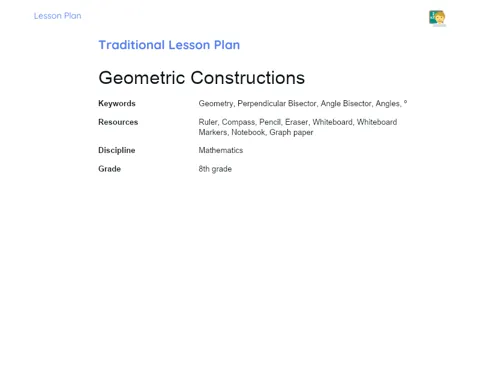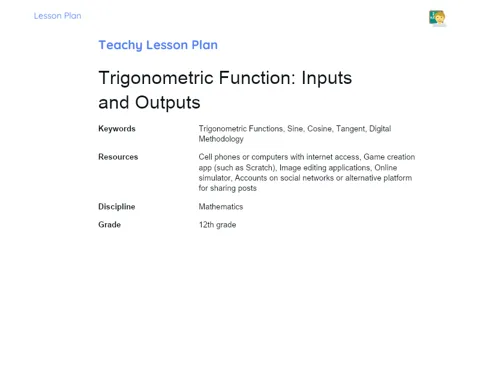Objectives (5 - 7 minutes)
-
Teach students to identify missing values in addition and subtraction problems, encouraging them to think critically about numerical relationships and the logic behind calculations.
-
Develop students' ability to complete numerical sequences, promoting an understanding that mathematics is a discipline of patterns and relationships.
-
Encourage active student participation through practical and interactive activities involving problem-solving and teamwork.
Secondary Objectives:
- Foster logical thinking in students, teaching them to analyze and solve mathematical problems in a structured way.
- Encourage communication and collaboration among students through group discussions and team activities.
Introduction (10 - 15 minutes)
-
To start the lesson, the teacher can begin by reviewing the basic concepts of addition and subtraction, using simple examples that students can easily understand, such as counting candies in a box or taking candies out of a bag. It is important to ensure that all students have a basic understanding of these concepts before moving on to the main topic.
-
Next, the teacher can propose two problem situations involving addition and subtraction. The situations should be challenging enough to stimulate students' critical thinking, but also designed in a way that allows students to easily identify the missing values. For example:
- "I had 5 apples and ate some. Now I have 3 apples. How many apples did I eat?"
- "I had 10 pencils and received some more. Now I have 15 pencils. How many pencils did I receive?"
-
After discussing the answers to the problem situations, the teacher can introduce the concept of missing values, explaining that sometimes in a math problem, we know the answer and some of the numbers that were used to reach that answer, but we do not know one or more numbers. This is what we call a 'missing value'.
-
The teacher can then contextualize the concept of missing values, showing how it is applied in everyday life. For example, in a cake recipe, if we know the quantity of ingredients we need but do not know the quantity of a specific ingredient, we can use the concept of missing value to find out the required quantity.
-
Finally, the teacher can introduce the lesson topic: 'Addition and Subtraction: Missing Values'. To engage students, the teacher can explain that they will learn to solve math problems that resemble a puzzle, where they need to find the missing value to complete the picture. The teacher can also emphasize the importance of this topic, highlighting that it is an essential mathematical skill that they will use in many real-life situations.
Development (20 - 25 minutes)
In this stage, the teacher will guide students through three practical and fun activities designed to help them understand and apply the concept of missing values in addition and subtraction problems. The activities are:
Activity 1: 'Treasure Hunt of Missing Values'
-
The teacher divides the class into small groups of 3 to 4 students, giving each group a set of cards numbered from 1 to 20.
-
The teacher then reads a addition or subtraction problem, but omits one of the numbers, replacing it with a blank space at the end of the problem. For example: "I had 7 balloons and gave some to my friend. Now I have ______ balloons. How many balloons did I give to my friend?"
-
Each group must then discuss the possible answer to the problem and find the card with the number that correctly completes the problem. The group that finds the right number first earns a point.
-
The teacher repeats the process with other addition and subtraction problems, encouraging the groups to work quickly and collaboratively.
Activity 2: 'Completing the Sequences'
-
The teacher prepares a series of cards with incomplete numerical sequences. For example, one card may have the sequence '10, 13, 16, ___, 22' and another card may have the sequence '9, 7, 5, ___, 0'.
-
Once again, students are divided into small groups and each group receives a set of cards.
-
The teacher reads an incomplete sequence and asks the groups to discuss and fill in the missing number. The group that gets it right earns a point.
-
The teacher continues reading sequences, gradually increasing the complexity to challenge the students. This helps develop students' ability to perceive patterns and numerical sequences.
Activity 3: 'Connecting the Dots'
-
The teacher gives each group a sheet of paper with a grid of numbered points.
-
The teacher then reads a series of addition and subtraction problems, and the groups must use a pen to connect the starting point with the ending point, forming a line. For example: "I had 5 balloons and gave 3 to my sister. Now I have ______ balloons. How many balloons do I have now?"
-
The teacher circulates around the room, guiding and assisting the groups as needed.
-
Once all problems are solved, students can check their answers. If all lines intersect at a central point on the grid, students know they have found the correct answer. Otherwise, they can correct their calculations.
These practical activities are designed to actively engage students in a collaborative manner, reinforcing the understanding of the concept of missing values in addition and subtraction problems. By the end of this stage, students should be able to identify and solve problems involving missing values, using addition and subtraction operations correctly and effectively.
Feedback (10 - 15 minutes)
-
After the completion of the practical activities, the teacher should gather all students in a large circle for the feedback stage. Each group will have the opportunity to share their solutions and the processes they used to reach them. The teacher should encourage students to explain their strategies using appropriate mathematical language for their age group, such as 'I knew I had to subtract because the problem said 'gave some'', or 'I noticed the sequence was decreasing by 3, so I knew I had to subtract'.
-
During this group discussion, the teacher should ask questions to clarify concepts, reinforce learning, and promote reflection, such as 'Why do you think the answer is 4 and not 5?', or 'Can you think of other ways to solve this problem?'.
-
Next, the teacher should provide an overview of the concepts learned, emphasizing the importance of the lesson topic and how it relates to students' daily lives. For example, the teacher may mention real-life situations where the ability to identify missing values in addition and subtraction problems is useful, such as in a grocery shopping scenario, where the total purchase amount and some of the prices are known, but the price of a specific item is unknown.
-
The teacher should then propose two or three challenging problems for students to solve individually. These problems should involve the application of the concept of missing values in addition and subtraction, and should be carefully selected to ensure they are suitable for the students' skill level. The teacher should move around the room as students solve the problems, offering support as needed.
-
Finally, the teacher should conclude the lesson by reinforcing the key points learned and ensuring that students understand the importance of what was learned. For example, the teacher may say: 'Today, we learned how to find missing values in addition and subtraction problems. This helps us solve math problems that resemble a puzzle, where we need to find the right number to complete the picture. This is a very useful skill, not only for math but also for everyday life. You did a great job today, and I am very proud of the effort you put into your activities. Remember, math is fun, and you are capable of solving any problem you encounter!'
Conclusion (5 - 7 minutes)
-
To conclude the lesson, the teacher should summarize the key points covered, recalling the definition of missing values in addition and subtraction problems, and how students learned to identify and solve these missing values. The teacher can do this interactively by asking students to share what they remember about the topic and filling in the necessary information.
-
Next, the teacher should briefly review the activities carried out during the lesson, highlighting the solutions found by the groups and the strategies used. The teacher can ask students which activities they enjoyed the most and why, and if they have any questions or difficulties they would like to discuss.
-
The teacher should then connect what was learned to real-life situations, explaining that the ability to identify missing values is useful not only in math problems but also in everyday situations. For example, when baking a cake, if we know the quantity of some ingredients but not the quantity of a specific ingredient, we can use the ability to identify missing values to find out the required quantity.
-
To encourage continuous learning, the teacher can suggest a list of additional resources for students to explore at home, such as interactive online games, textbooks, or educational math videos. The teacher can also provide some tips on how parents can help students practice identifying missing values at home, for example, by asking students to solve addition and subtraction problems in daily life or creating math games involving identifying missing values.
-
Finally, the teacher should reinforce the importance of the topic learned and express confidence in students' ability to apply what they have learned. The teacher may say: 'Today, we learned a very important skill: how to identify missing values in addition and subtraction problems. This is a skill that you will use not only in math but also in many real-life situations. I know that you are capable of applying what you have learned, and I look forward to seeing how you will use this skill in the future.'



